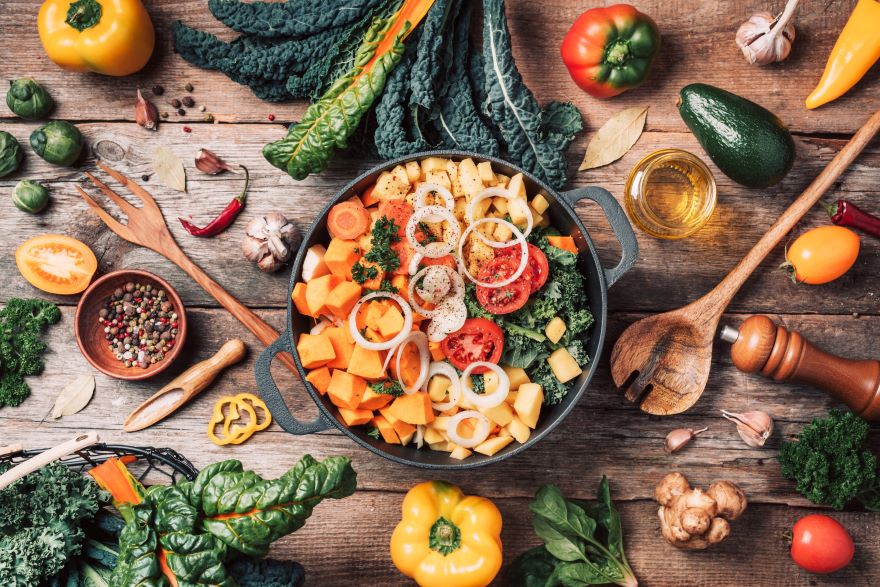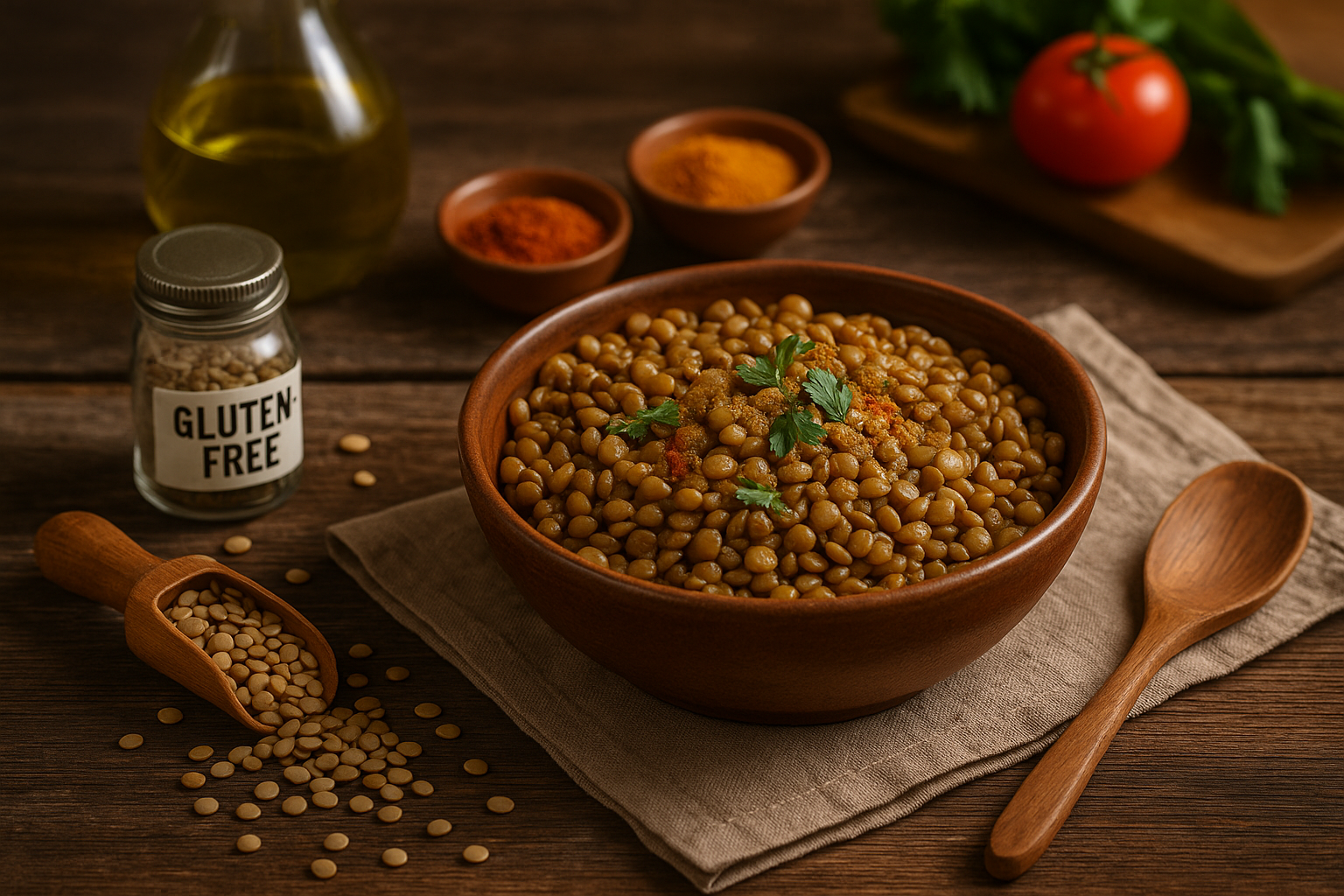Dairy-free cooking opens up a world of possibilities that extends beyond just human consumption. The rich aromas of roasted vegetables, the creamy textures of cashew-based sauces, and the satisfying golden crust of a perfectly baked casserole prove that dairy-free doesn’t mean flavor-free. When I first started this journey, it wasn’t just about finding alternatives – it was about discovering new dimensions of taste and texture that I never knew existed.
As someone passionate about inclusive cooking, I’ve discovered that creating delectable dairy-free casseroles isn’t just about catering to human dietary needs – it’s about crafting meals that can bring joy to every member of our household, including our beloved pets. Whether you’re dealing with lactose intolerance, choosing a plant-based lifestyle, or looking to prepare something special for your furry friends, the art of dairy-free casserole making is both accessible and rewarding.

Why Choose Dairy-Free? A Personal Perspective
The choice to embrace dairy-free cooking aligns perfectly with Dr. Fuhrman’s Nutritarian diet principles, which I’ve followed and discussed in my previous articles. His emphasis on plant-based nutrition has shown me how dairy-free alternatives can enhance our health while satisfying our taste buds. Whether you’re dealing with lactose intolerance, following a plant-based lifestyle, or simply exploring healthier options, dairy-free cooking opens doors to creative and nutritious meals.
What excites me most is how dairy-free cooking transforms traditional recipes through innovation. Creating creamy sauces from cashews or watching skeptical friends enjoy their first bite of a dairy-free casserole proves that healthy eating doesn’t mean compromising on taste. This approach has not only improved my own health but has also positively impacted my pets’ wellbeing, showing that good nutrition benefits the entire family.
Getting Started with Dairy-Free Cooking
Following Dr. Fuhrman’s Nutritarian principles opened my eyes to the power of plant-based nutrition, leading me to explore dairy-free cooking more deeply. What began as a commitment to better health through his dietary guidelines soon expanded to benefit my entire household. The transformation was remarkable – not only did my family embrace these healthier, dairy-free alternatives, but my pets, Sophie (my adorable dog) and Simba (my curious cat), showed genuine interest in their specially crafted pet-friendly versions.
Creating pet-friendly dairy-free casseroles requires extra attention to ingredient selection, as many common human ingredients can be harmful to our four-legged friends. For instance, while onions and garlic are staples in human casseroles, they’re toxic to both dogs and cats. This realization led me to develop separate recipes that are both nutritious and safe for our beloved pets while maintaining the same level of care and creativity that goes into human-grade dishes.
Understanding Dairy-Free Ingredients for All
Human-Grade Alternatives
The foundation of any great dairy-free casserole lies in selecting the right alternatives to traditional dairy products. For human consumption, I’ve found success with:
- Plant-based milks (soy, almond, oat, rice, coconut)
- Cashew-based cream sauces
- Nutritional yeast for cheesy flavor
- Coconut milk for rich, creamy textures
- Olive oil for sautéing and moisture
For creamy cashew-based sauces or perfectly blended vegetable purees, a high-performance blender is indispensable. The Vitamix A3500 Ascent Series Smart Blender delivers consistent, silky results every time, making it an essential tool for dairy-free cooking. Its precision and power allow you to create smooth sauces that mimic traditional dairy-based options with ease.
- 64-Ounce Container is ideal for medium to large-sized blends
- Program Settings: Five program settings (for Smoothies, Hot Soups, Dips & Spreads, Frozen Desserts, and Self-Cleaning) ensure walk-away convenience and consistent results
- Touchscreen Controls give the machine a sleek silhouette and are easily wiped clean
- Variable Speed Control and Pulse feature let you manually fine-tune the texture of any recipe
- Wireless Connectivity: The motor base can detect the container size and automatically adjust program settings and maximum blending times accordingly. Add a range of compatible containers and attachments, building a customized system designed to fit your needs
Pet-Safe Alternatives
For our furry friends, we need to be more selective. Safe alternatives include:
Pet-safe oils like salmon oil or coconut oil
Plain, unsweetened coconut milk (in moderation)
Bone broth (unseasoned)
Pureed sweet potato for creaminess
Cooked and mashed carrots
The Art of Label Reading
When preparing dairy-free dishes, careful label reading becomes crucial. For human consumption, watch out for hidden dairy ingredients like:
- Whey
- Casein
- Lactose
- Milk derivatives
- Modified milk ingredients
For pet-friendly recipes, additional ingredients to avoid include:
- Onion powder
- Garlic powder
- Artificial sweeteners
- High sodium content
- Preservatives

Essential Kitchen Preparation
Equipment Needs
When it comes to bakeware, investing in quality equipment makes a significant difference in your dairy-free cooking success.
For the perfect dairy-free casseroles, I highly recommend the Emile Henry HR Modern Classics Large Rectangular Baker. Made from high-fired Burgundy clay, it ensures even heat distribution and excellent thermal resistance. Its generous capacity and versatile design suit a wide variety of casseroles, while the scratch-resistant glaze is easy to clean.
- MADE IN FRANCE SINCE 1850. Made of all natural materials. High-fired Burgundy clay using Emile Henry HR ceramic (high resistance)
- SUPERIOR HEAT RETENTION. Burgundy clay has superior even-heat diffusion and heat retention properties; it keeps food hot on the table longer.
- RESISTANT AGAINST TEMPERATURE CHANGE. For use in the oven up to 520F degrees. Oven, broiler, and microwave safe: Can go directly from freezer or refrigerator, to a hot oven, to Table.
- DURABLE AND SCRATCH RESISTANT. Extremely hard glaze does not scratch and does not craze. Durable for everyday use. The highly resistant glaze is ideal in the kitchen for making delicious meals and desserts.
- EASY TO CLEAN. Dishwasher safe or hand wash with soap and water. 10 YEAR GUARANTEE against manufacturing defects when used in a household environment.
This baker has consistently delivered outstanding results in my kitchen.
Additional essential equipment includes:
- Additional baking dish (separate one for pet food)
- Non-stick cookware
- Mixing bowls
- Food processor for pureeing vegetables
- Storage containers for leftovers
Temperature Control
- Preheat oven to recipe-specific temperature
- For pet food, ensure thorough cooking but avoid burning
- Allow dishes to cool completely before serving to pets
When it comes to sautéing vegetables or preparing the base for your dairy-free casseroles, having a high-quality pan is crucial. The All-Clad Stainless Steel 12-Inch Fry Pan with Lid ensures even heating and professional results every time. Its durable construction and versatile design make it perfect for all your cooking needs, from caramelizing onions to browning proteins.
- Even Heat Distribution: Experience fast and consistent cooking results with our All Clad stainless steel fry pan, featuring triply stainless steel construction for excellent heat distribution
- Superior Searing Surface: The high-quality 18/10 stainless steel surface of this All-Clad D3 stainless steel 12 inch fry pan with lid is ideal for searing
- Durable and Versatile Design: This 12 inch stainless steel frying pan features a polished finish, made for high-heat cooking techniques such as flipping and tossing foods
- Oven and Broiler Safe: Designed to withstand up to 600°F, this All-Clad 12 inch fry pan provides flexibility for oven use, ideal for all types of cooking surfaces
- Secure Grip: Our All Clad stainless steel fry pan feature double riveted stainless steel handles, providing a secure, comfortable grip during frying and other tasks
Signature Recipes

For Human Consumption: A Sensory Experience
When you make these recipes, prepare for a feast for all your senses. The transformation that happens in the oven creates a symphony of aromas, textures, and flavors that will make you forget you’re eating dairy-free.
Creamy Vegetable Medley Casserole
Serves 6-8
Ingredients:
- 2 cups cauliflower, chopped
- 2 cups broccoli florets
- 1 cup carrots, sliced
- 1 cup cashews, soaked
- 2 cups unsweetened almond milk
- 3 tablespoons nutritional yeast
- 1 cup dairy-free cheese shreds
- 1 cup breadcrumbs
- Herbs and seasonings to taste
Instructions and Sensory Guide:
- Preheat the oven to 375°F (190°C). The warming oven will start to create an inviting atmosphere in your kitchen.
- Steam vegetables until tender-crisp. They should maintain their vibrant colors – bright green broccoli, sunny orange carrots. When pierced with a fork, they should offer just slight resistance.
- Blend cashews with almond milk until silky smooth. The mixture should be velvety and thick, with no graininess when rubbed between your fingers. It should coat the back of a spoon like heavy cream.
- Combine sauce with vegetables. The sauce should hug each vegetable piece, creating a harmonious blend of colors and textures.
- Top with dairy-free cheese and breadcrumbs. The topping should create an even, golden-promising layer.
- Bake for 25-30 minutes until golden. Your kitchen will fill with a nutty, toasted aroma. The top should be crispy and golden brown, with bubbling sounds coming from the edges. When done, the casserole should have a perfect balance of creamy interior and crispy top.
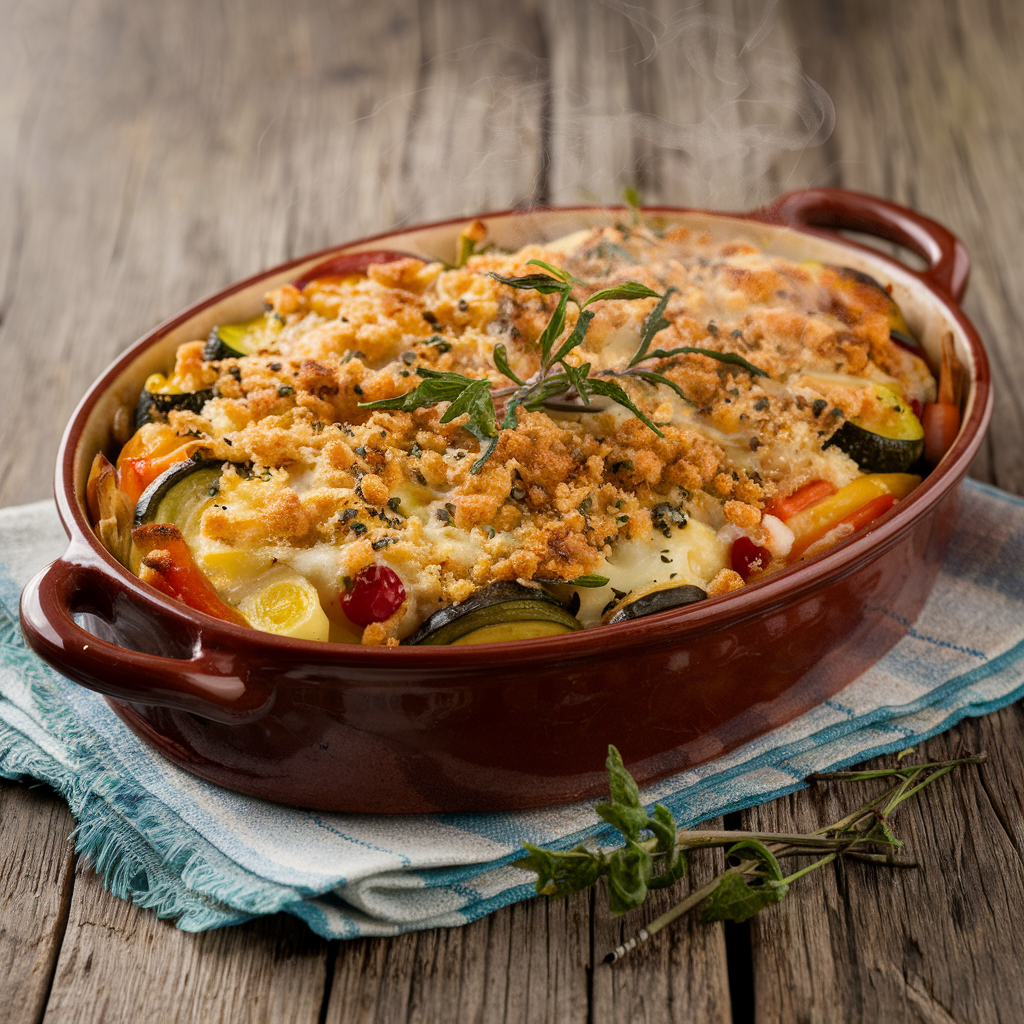
For Your Furry Friends
Sophie and Simba’s Special Casserole
Makes multiple servings (portion according to pet size)
Ingredients:
- 2 cups lean ground turkey or organic chicken
- 1 cup sweet potato, mashed
- 1 cup carrots, finely diced
- 1 cup green beans, chopped
- 1 cup cooked brown rice
- 2 eggs
- 1/4 cup coconut milk (unsweetened)
- 1 tablespoon salmon oil
- Calcium powder (pet supplement)
Instructions:
- Preheat oven to 350°F (175°C)
- Cook meat thoroughly
- Steam and mash vegetables
- Combine all ingredients
- Bake in greased dish for 20-25 minutes
- Cool completely before serving
Note: Always consult with your veterinarian before introducing new foods to your pets’ diet.
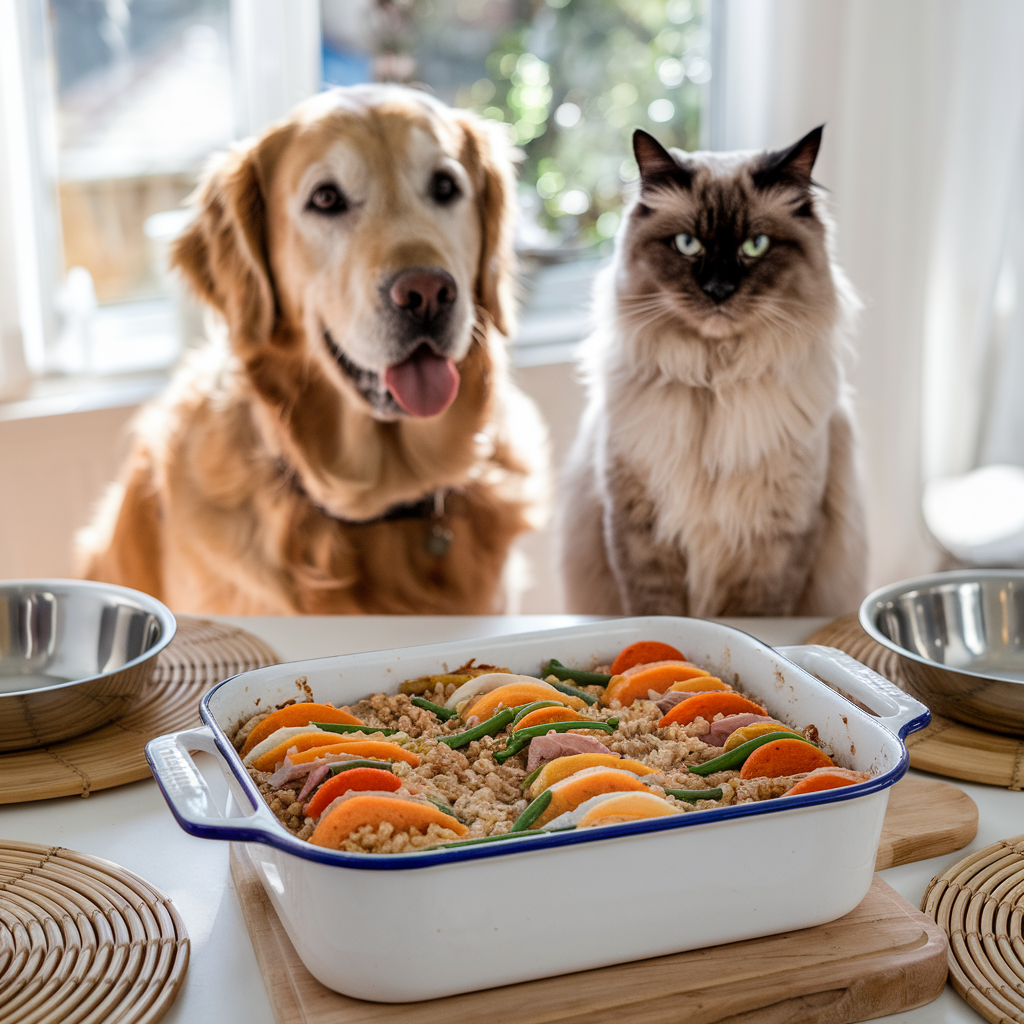
Nutritional Considerations
For Humans
Ensuring nutritional balance in dairy-free cooking means paying attention to:
- Calcium intake through fortified plant milk and leafy greens
- Protein from legumes and plant-based sources
- Vitamin B12 and D through fortified foods
- Healthy fats from nuts and plant oils
For Pets
Pet nutrition requires special consideration:
- Proper protein-to-fat ratio
- Essential amino acids
- Calcium and phosphorus balance
- Appropriate portion sizes
- Gradual introduction of new foods
Storage and Meal Prep Guidelines
Human Casseroles
- Cool completely before refrigerating
- Store in airtight containers
- Consume within 3-4 days
- Can be frozen for up to 3 months
- Reheat thoroughly before serving
Pet Casseroles
- Portion into single servings
- Store in pet-food specific containers
- Refrigerate up to 2 days
- Freeze individual portions up to 1 month
- Thaw in refrigerator overnight
- Warm slightly before serving
Tips for Success
General Casserole Making
- Layer ingredients properly for even cooking
- Monitor moisture levels
- Check internal temperature
- Allow resting time after baking
- Use appropriate portion sizes
Pet-Specific Considerations
- Introduce new foods gradually
- Watch for any adverse reactions
- Maintain consistent portion sizes
- Keep treats to 10% of daily calories
- Store pet food separately from human food
Overcoming Common Challenges
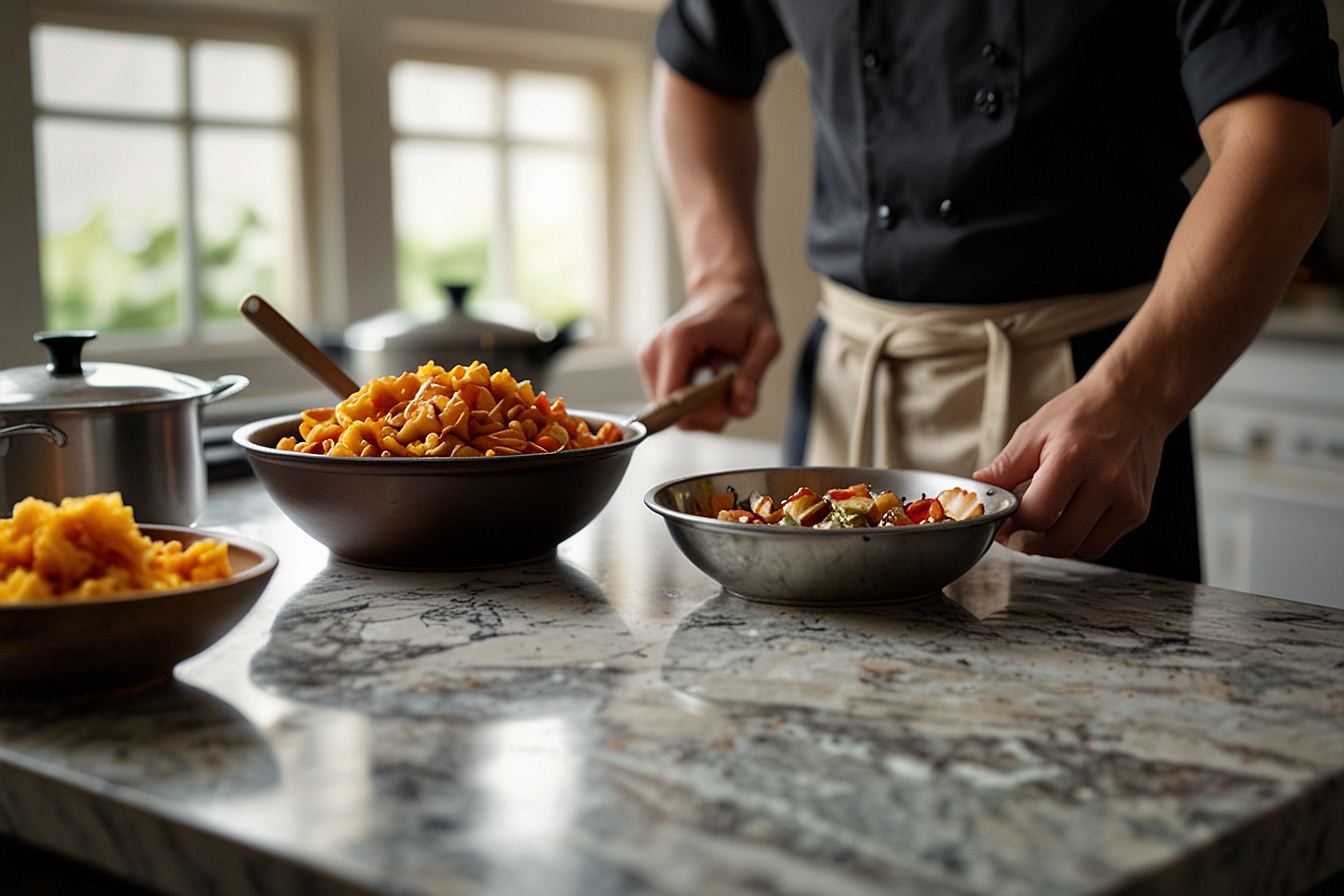
The path to dairy-free cooking mastery isn’t without its hurdles, but understanding these challenges makes success much more attainable. Here’s a comprehensive guide to common issues and their solutions, drawn from years of both triumphs and learning experiences in my kitchen.
Texture Problems and Solutions
Human Casseroles
- Too dry:
- Cause: Insufficient liquid or overcooking
- Solution: Add warm broth or plant milk before reheating
- Prevention: Monitor liquid ratios and cooking time carefully
- Sensory cue: If the top looks cracked or the edges are pulling away, add moisture
- Too wet:
- Cause: Excess liquid from vegetables or sauce
- Solution: Extend cooking time with foil removed
- Prevention: Pre-cook high-moisture vegetables
- Sensory cue: Look for bubbling around edges that’s thick, not watery
- Grainy sauce:
- Cause: Improperly blended nuts or separated plant milk
- Solution: Blend longer with high-powered blender
- Prevention: Soak nuts thoroughly and use room-temperature liquids
- Sensory cue: Sauce should be silky smooth with no grittiness
Flavor Balance
- Bland taste:
- Cause: Insufficient seasoning or missing umami
- Solution: Add nutritional yeast, miso, or mushroom powder
- Prevention: Layer flavors throughout cooking
- Sensory cue: Each bite should have complex, developed flavors
- Uneven seasoning:
- Cause: Poor distribution of spices
- Solution: Mix seasonings with liquid components
- Prevention: Season each layer separately
- Sensory cue: Consistent flavor in every bite
Pet Casseroles
Common Issues
- Texture inconsistency:
- Cause: Improper ingredient ratios
- Solution: Adjust liquid-to-solid ratios
- Prevention: Follow recipes precisely for pet food
- Sensory cue: Should hold shape but be easily mashable
- Palatability problems:
- Cause: Temperature or texture issues
- Solution: Serve at room temperature
- Prevention: Test small portions first
- Sensory cue: Pets should show immediate interest
Safety Concerns
- Temperature issues:
- Cause: Serving too hot or cold
- Solution: Allow proper cooling time
- Prevention: Use a food thermometer
- Sensory cue: Should be just warm to touch
- Storage problems:
- Cause: Improper containers or temperature
- Solution: Use air-tight, pet-food specific containers
- Prevention: Portion immediately after cooling
- Sensory cue: No off odors or discoloration
Human Casseroles

- Too dry: Add more liquid before reheating
- Too wet: Extend cooking time
- Uneven cooking: Rotate dish during baking
- Lacking flavor: Enhance with herbs and seasonings
Pet Casseroles
- Texture issues: Adjust cooking time
- Palatability: Try different protein sources
- Storage problems: Use smaller containers
- Temperature concerns: Ensure proper cooling
Beyond Basic Recipes
Creative Variations for Humans
- Mexican-inspired casseroles with beans and corn
- Italian-style with dairy-free bechamel
- Asian-fusion with coconut milk base
- Mediterranean with olive and herb focus
Pet-Friendly Variations
- Different grain combinations
- Fish-based options (using salmon or white fish)
- Poultry variations
- Lamb-based recipes
Community and Sharing
Creating dairy-free dishes brings people together. Sharing these recipes with fellow pet parents has fostered a wonderful community of health-conscious cooks who care about both human and animal nutrition. Many pet owners are eager to learn how to make homemade, dairy-free meals for their furry friends. This exchange of ideas has sparked countless creative variations on basic recipes

Final Thoughts
Embracing dairy-free cooking through Dr. Fuhrman’s Nutritarian principles has revealed an incredible world of healthy, flavorful possibilities. From mastering nutrient-rich cashew-based sauces to creating wholesome, golden-crusted casseroles that prove plant-based alternatives can surpass their traditional counterparts, this approach to cooking has transformed not just my meals, but my entire family’s relationship with food.
We’ve explored how simple ingredient swaps and thoughtful preparation can transform everyday meals. Through careful label reading, proper kitchen preparation, and understanding the nutritional aspects of dairy-free cooking, anyone can create delicious, wholesome meals that cater to various dietary needs and preferences.
True dietary transformation extends beyond our own plates – it touches every member of our household, including our beloved pets. When we choose to make significant changes to our eating habits, we have the unique opportunity to enhance not just our own wellbeing, but also that of our entire family. Our furry companions share our homes, our love, and yes, even our dietary considerations.
taking a mindful, inclusive approach to dairy-free cooking, we create a more harmonious and healthier household for everyone. Remember, whether they walk on two legs or four, every family member deserves nutritious, carefully prepared meals that cater to their specific needs. The joy of cooking lies not just in the flavors we create, but in the love and consideration we pour into every dish we prepare for those we cherish. Let this be your guide as you continue to explore and expand your dairy-free culinary adventures.
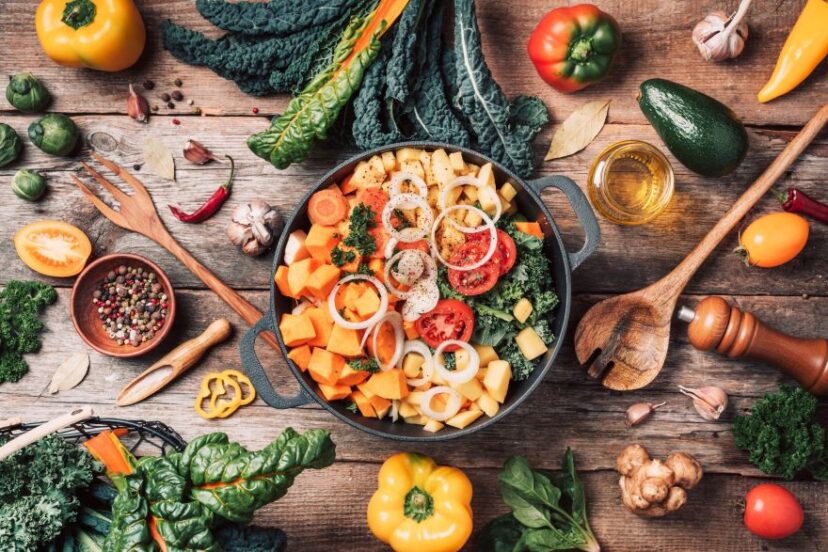
*We may earn a commission for purchases made using our links. Please see our disclosure to learn more.

